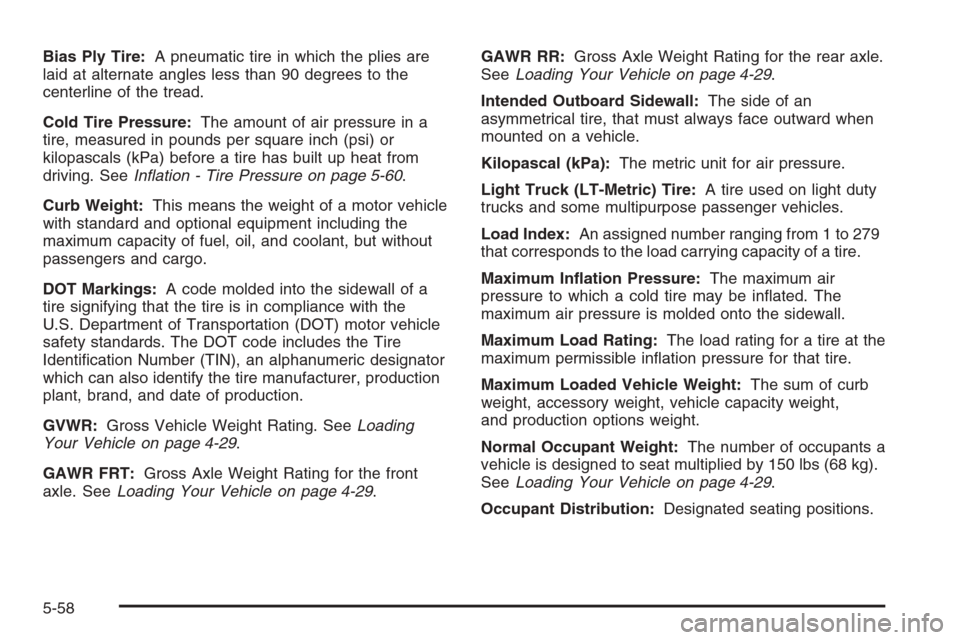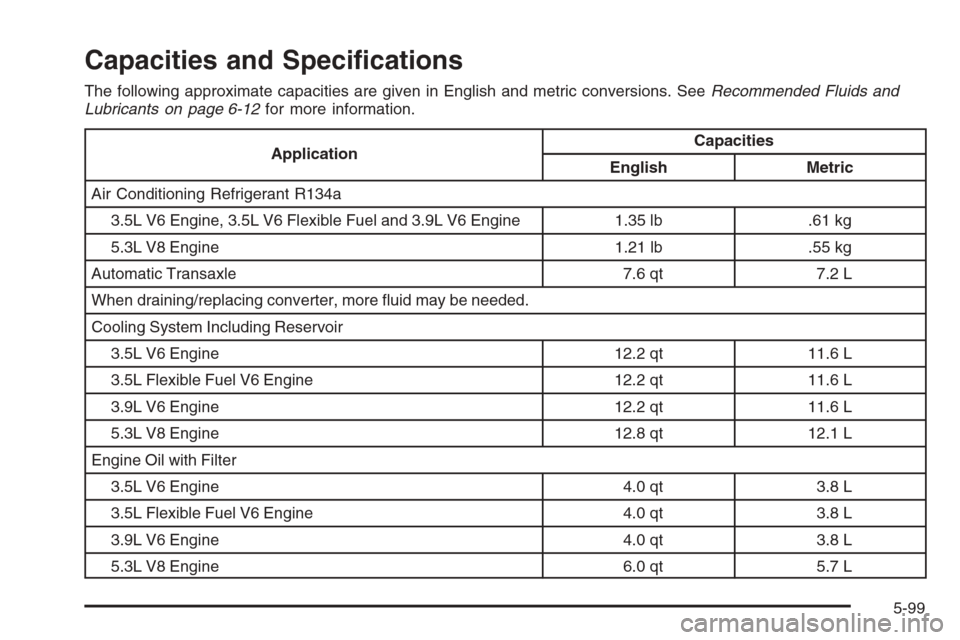2006 CHEVROLET IMPALA fuel cap
[x] Cancel search: fuel capPage 265 of 394

A. Windshield Washer Fluid Reservoir. See “Adding
Washer Fluid” underWindshield Washer Fluid
on page 5-39.
B. Battery. SeeBattery on page 5-43.
C. Underhood Fuse Block. SeeUnderhood Fuse Block
on page 5-96.
D. Remote Positive (+) Terminal. SeeJump Starting
on page 5-44.
E. Pressure Cap. SeePressure Cap on page 5-28.
F. Power Steering Fluid Reservoir. SeePower Steering
Fluid on page 5-38.
G. Engine Oil Dipstick. See “Checking Engine Oil”
underEngine Oil on page 5-17.
H. Engine Oil Fill Cap. See “When to Add Engine Oil”
underEngine Oil on page 5-17.
I. Automatic Transaxle Fluid Dipstick. See “Checking
the Fluid Level” underAutomatic Transaxle Fluid
on page 5-23.
J. Brake Master Cylinder Reservoir. See “Brake Fluid”
underBrakes on page 5-40.
K. Engine Air Cleaner/Filter. SeeEngine Air
Cleaner/Filter on page 5-22.
L. Coolant Recovery Tank. See “Checking Coolant”
underCooling System on page 5-31.Engine Oil
If the ENGINE OIL LOW ADD OIL message appears
in the Driver Information Center (DIC), it means
you need to check the engine oil level right away.
For more information, seeDIC Warnings and Messages
on page 3-45. You should check the engine oil level
regularly; this is an added reminder.
Checking Engine Oil
It is a good idea to check the engine oil every time you
get fuel. In order to get an accurate reading, the oil
must be warm and the vehicle must be on level ground.
The engine oil dipstick handle is a yellow loop. See
Engine Compartment Overview on page 5-12for
the location of the engine oil dipstick.
1. Turn off the engine and give the oil several minutes
to drain back into the oil pan. If you do not do this,
the oil dipstick might not show the actual level.
2. Pull out the dipstick and clean it with a paper towel
or cloth, then push it back in all the way. Remove it
again, keeping the tip down, and check the level.
5-17
Page 306 of 394

Bias Ply Tire:A pneumatic tire in which the plies are
laid at alternate angles less than 90 degrees to the
centerline of the tread.
Cold Tire Pressure:The amount of air pressure in a
tire, measured in pounds per square inch (psi) or
kilopascals (kPa) before a tire has built up heat from
driving. SeeIn�ation - Tire Pressure on page 5-60.
Curb Weight:This means the weight of a motor vehicle
with standard and optional equipment including the
maximum capacity of fuel, oil, and coolant, but without
passengers and cargo.
DOT Markings:A code molded into the sidewall of a
tire signifying that the tire is in compliance with the
U.S. Department of Transportation (DOT) motor vehicle
safety standards. The DOT code includes the Tire
Identi�cation Number (TIN), an alphanumeric designator
which can also identify the tire manufacturer, production
plant, brand, and date of production.
GVWR:Gross Vehicle Weight Rating. SeeLoading
Your Vehicle on page 4-29.
GAWR FRT:Gross Axle Weight Rating for the front
axle. SeeLoading Your Vehicle on page 4-29.GAWR RR:Gross Axle Weight Rating for the rear axle.
SeeLoading Your Vehicle on page 4-29.
Intended Outboard Sidewall:The side of an
asymmetrical tire, that must always face outward when
mounted on a vehicle.
Kilopascal (kPa):The metric unit for air pressure.
Light Truck (LT-Metric) Tire:A tire used on light duty
trucks and some multipurpose passenger vehicles.
Load Index:An assigned number ranging from 1 to 279
that corresponds to the load carrying capacity of a tire.
Maximum In�ation Pressure:The maximum air
pressure to which a cold tire may be in�ated. The
maximum air pressure is molded onto the sidewall.
Maximum Load Rating:The load rating for a tire at the
maximum permissible in�ation pressure for that tire.
Maximum Loaded Vehicle Weight:The sum of curb
weight, accessory weight, vehicle capacity weight,
and production options weight.
Normal Occupant Weight:The number of occupants a
vehicle is designed to seat multiplied by 150 lbs (68 kg).
SeeLoading Your Vehicle on page 4-29.
Occupant Distribution:Designated seating positions.
5-58
Page 308 of 394

In�ation - Tire Pressure
Tires need the correct amount of air pressure to
operate effectively.
Notice:Do not let anyone tell you that
under-in�ation or over-in�ation is all right. It is not.
If your tires do not have enough air (under-in�ation),
you can get the following:
Too much �exing
Too much heat
Tire overloading
Premature or irregular wear
Poor handling
Reduced fuel economy
If your tires have too much air (over-in�ation),
you can get the following:
Unusual wear
Poor handling
Rough ride
Needless damage from road hazardsA Tire and Loading Information label is attached to the
vehicle’s center pillar (B-pillar). This label shows
your vehicle’s original equipment tires and the correct
in�ation pressures for your tires when they are cold. The
recommended cold tire in�ation pressure, shown on
the label, is the minimum amount of air pressure needed
to support your vehicle’s maximum load carrying
capacity.
For additional information regarding how much weight
your vehicle can carry, and an example of the Tire
and Loading Information label, seeLoading Your Vehicle
on page 4-29. How you load your vehicle affects
vehicle handling and ride comfort. Never load your
vehicle with more weight than it was designed to carry.
When to Check
Check your tires once a month or more. Do not forget
to check the compact spare tire, it should be at
60 psi (420 kPa). For additional information regarding
the compact spare tire, seeCompact Spare Tire
on page 5-83.
How to Check
Use a good quality pocket-type gage to check tire
pressure. You cannot tell if your tires are properly
in�ated simply by looking at them. Radial tires may look
properly in�ated even when they are under-in�ated.
5-60
Page 347 of 394

Capacities and Speci�cations
The following approximate capacities are given in English and metric conversions. SeeRecommended Fluids and
Lubricants on page 6-12for more information.
ApplicationCapacities
English Metric
Air Conditioning Refrigerant R134a
3.5L V6 Engine, 3.5L V6 Flexible Fuel and 3.9L V6 Engine 1.35 lb .61 kg
5.3L V8 Engine 1.21 lb .55 kg
Automatic Transaxle 7.6 qt 7.2 L
When draining/replacing converter, more �uid may be needed.
Cooling System Including Reservoir
3.5L V6 Engine 12.2 qt 11.6 L
3.5L Flexible Fuel V6 Engine 12.2 qt 11.6 L
3.9L V6 Engine 12.2 qt 11.6 L
5.3L V8 Engine 12.8 qt 12.1 L
Engine Oil with Filter
3.5L V6 Engine 4.0 qt 3.8 L
3.5L Flexible Fuel V6 Engine 4.0 qt 3.8 L
3.9L V6 Engine 4.0 qt 3.8 L
5.3L V8 Engine 6.0 qt 5.7 L
5-99
Page 348 of 394

ApplicationCapacities
English Metric
Fuel Tank 17.5 gal 66.2 L
Wheel Nut Torque 100 lb ft 140 Nm
All capacities are approximate. When adding, be sure to �ll to the approximate level, as recommended in
this manual. Recheck �uid level after �lling.
Engine Speci�cations
Engine VIN Code Transaxle Spark Plug Gap
3.5L V6 N Automatic 0.040 inches (1.01 mm)
3.5L Flexible Fuel V6 K Automatic 0.040 inches (1.01 mm)
3.9L V6 1 Automatic 0.040 inches (1.01 mm)
5.3L V8 C Automatic 0.040 inches (1.01 mm)
5-100
Page 382 of 394

Audio System(s) (cont.)
Radio with CD....................................3-62, 3-67
Setting the Time..........................................3-60
Theft-Deterrent Feature................................3-83
Understanding Radio Reception.....................3-84
XM™ Satellite Radio Antenna System............3-86
Automatic Door Lock.......................................2-11
Automatic Transaxle
Fluid..........................................................5-23
Operation...................................................2-25
B
Backglass Antenna..........................................3-85
Battery..........................................................5-43
Run-Down Protection...................................3-17
Before Leaving on a Long Trip.........................4-21
Brake
Anti-Lock Brake System (ABS)........................ 4-7
Emergencies................................................ 4-9
Parking......................................................2-28
System Warning Light..................................3-30
Brakes..........................................................5-40
Braking........................................................... 4-6
Braking in Emergencies..................................... 4-9
Break-In, New Vehicle.....................................2-20Bulb Replacement...........................................5-48
Halogen Bulbs............................................5-48
Headlamp Aiming........................................5-47
Headlamps, Front Turn Signal, Sidemarker,
and Parking Lamps..................................5-48
Replacement Bulbs......................................5-52
Taillamps, Turn Signal, Sidemarker,
Stoplamps, and Back-Up Lamps.................5-50
Buying New Tires...........................................5-66
C
Calibration.....................................................3-44
California Fuel.................................................. 5-5
California Proposition 65 Warning....................... 5-3
Canadian Owners................................................ ii
Capacities and Speci�cations............................5-99
Carbon Monoxide...................2-13, 2-32, 4-24, 4-36
Care of
Safety Belts................................................5-87
Your CD Player...........................................3-85
Your CDs ...................................................3-85
Center Console Storage Area...........................2-43
Center Front Passenger Position, Safety Belts....1-25
Center Seat..................................................... 1-9
Chains, Tire...................................................5-71
2